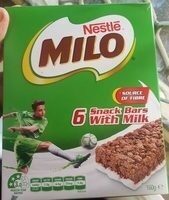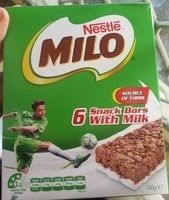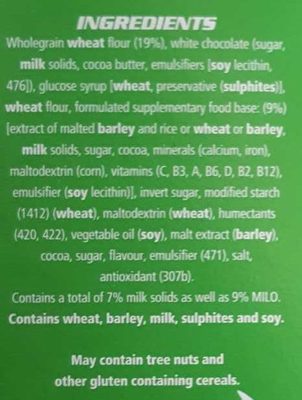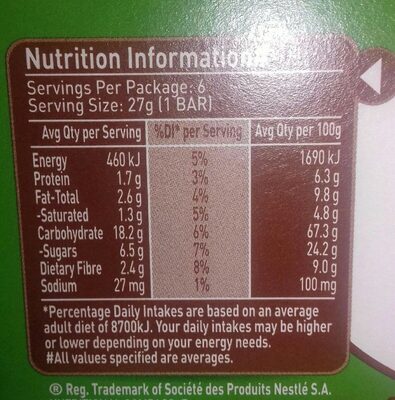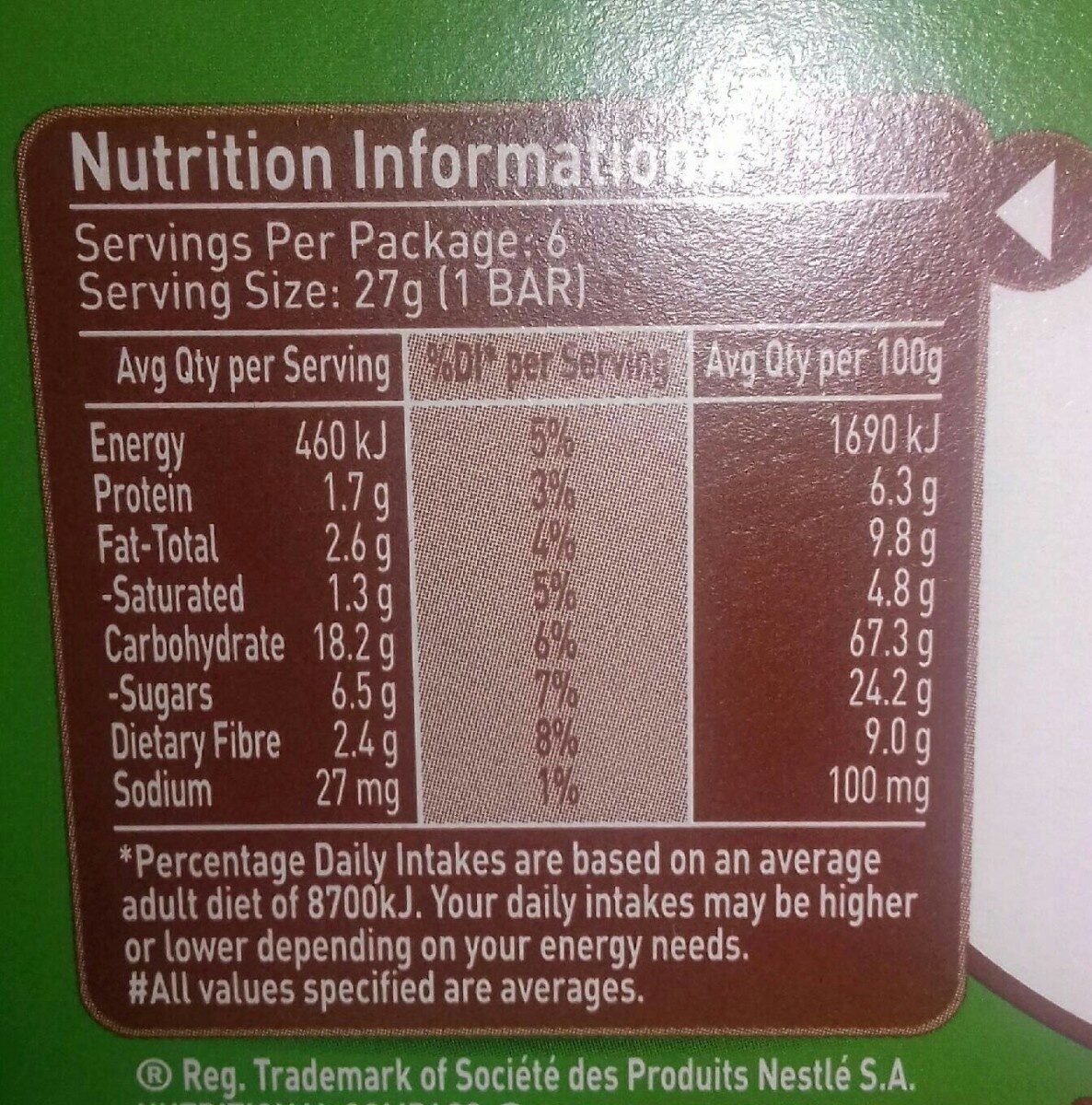Help us make food transparency the norm!
As a non-profit organization, we depend on your donations to continue informing consumers around the world about what they eat.
The food revolution starts with you!
Nestle Cereal Bars Milo - 160 g e
Nestle Cereal Bars Milo - 160 g e
This product page is not complete. You can help to complete it by editing it and adding more data from the photos we have, or by taking more photos using the app for Android or iPhone/iPad. Thank you!
×
Barcode: 9300605021648 (EAN / EAN-13)
Common name: Snack Cereal Bars with Milk
Quantity: 160 g e
Packaging: Plastic, Box, Cardboard
Categories: Snacks, Sweet snacks, Cocoa and its products, Confectioneries, Bars, Chocolate candies, Cereal bars, Candy chocolate bars
Labels, certifications, awards: Australian made
Link to the product page on the official site of the producer: http://btl.nestle.com.au/9300605021648/L...
Stores: Woolworths
Countries where sold: Australia, France, New Zealand
Matching with your preferences
Health
Ingredients
-
50 ingredients
Wholegrain wheat flour (19%), white chocolate (sugar, milk solids, cocoa butter, emulsifiers [soy lecithin, 476]), glucose syrup [wheat, preservative (sulphites)], wheat flour, formulated supplementary food base (9%) extract of malted barley and rice or wheat or barley milk solids, sugar, cocoa, minerals (calcium, iron), maltodextrin (com), vitamins (C, B3, A, B6, D, B2, B12), emulsifier (soy lecithin)], invert sugar, modified starch (1412) (wheat), maltodextrin (wheat), humectants (420, 422), vegetable oil (soy), malt extract (barley), cocoa, sugar, flavour, emulsifier (471), salt antioxidant (307b). Contains a total of 7% milk solids as well as 9% MILO. Contains wheat, barley, milk, sulphites and soyAllergens: Gluten, Milk, Soybeans, Sulphur dioxide and sulphitesTraces: Gluten, Nuts
Food processing
-
Ultra processed foods
Elements that indicate the product is in the 4 - Ultra processed food and drink products group:
- Additive: E1412 - Distarch phosphate
- Additive: E14XX - Modified Starch
- Additive: E322 - Lecithins
- Additive: E420 - Sorbitol
- Additive: E422 - Glycerol
- Additive: E471 - Mono- and diglycerides of fatty acids
- Additive: E476 - Polyglycerol polyricinoleate
- Ingredient: Emulsifier
- Ingredient: Flavouring
- Ingredient: Glucose
- Ingredient: Glucose syrup
- Ingredient: Humectant
- Ingredient: Invert sugar
- Ingredient: Maltodextrin
Food products are classified into 4 groups according to their degree of processing:
- Unprocessed or minimally processed foods
- Processed culinary ingredients
- Processed foods
- Ultra processed foods
The determination of the group is based on the category of the product and on the ingredients it contains.
Additives
-
E307b - Concentrated tocopherol
Alpha-Tocopherol: α-Tocopherol is a type of vitamin E. It has E number "E307". Vitamin E exists in eight different forms, four tocopherols and four tocotrienols. All feature a chromane ring, with a hydroxyl group that can donate a hydrogen atom to reduce free radicals and a hydrophobic side chain which allows for penetration into biological membranes. Compared to the others, α-tocopherol is preferentially absorbed and accumulated in humans.Source: Wikipedia
-
E322 - Lecithins
Lecithins are natural compounds commonly used in the food industry as emulsifiers and stabilizers.
Extracted from sources like soybeans and eggs, lecithins consist of phospholipids that enhance the mixing of oil and water, ensuring smooth textures in various products like chocolates, dressings, and baked goods.
They do not present any known health risks.
-
E322i - Lecithin
Lecithins are natural compounds commonly used in the food industry as emulsifiers and stabilizers.
Extracted from sources like soybeans and eggs, lecithins consist of phospholipids that enhance the mixing of oil and water, ensuring smooth textures in various products like chocolates, dressings, and baked goods.
They do not present any known health risks.
-
E420 - Sorbitol
Sorbitol: Sorbitol --, less commonly known as glucitol --, is a sugar alcohol with a sweet taste which the human body metabolizes slowly. It can be obtained by reduction of glucose, which changes the aldehyde group to a hydroxyl group. Most sorbitol is made from corn syrup, but it is also found in nature, for example in apples, pears, peaches, and prunes. It is converted to fructose by sorbitol-6-phosphate 2-dehydrogenase. Sorbitol is an isomer of mannitol, another sugar alcohol; the two differ only in the orientation of the hydroxyl group on carbon 2. While similar, the two sugar alcohols have very different sources in nature, melting points, and uses.Source: Wikipedia
-
E422 - Glycerol
Glycerol: Glycerol -; also called glycerine or glycerin; see spelling differences- is a simple polyol compound. It is a colorless, odorless, viscous liquid that is sweet-tasting and non-toxic. The glycerol backbone is found in all lipids known as triglycerides. It is widely used in the food industry as a sweetener and humectant and in pharmaceutical formulations. Glycerol has three hydroxyl groups that are responsible for its solubility in water and its hygroscopic nature.Source: Wikipedia
-
E471 - Mono- and diglycerides of fatty acids
Mono- and diglycerides of fatty acids (E471), are food additives commonly used as emulsifiers in various processed foods.
These compounds consist of glycerol molecules linked to one or two fatty acid chains, which help stabilize and blend water and oil-based ingredients. E471 enhances the texture and shelf life of products like margarine, baked goods, and ice cream, ensuring a smooth and consistent texture.
It is generally considered safe for consumption within established regulatory limits.
-
E476 - Polyglycerol polyricinoleate
Polyglycerol polyricinoleate: Polyglycerol polyricinoleate -PGPR-, E476, is an emulsifier made from glycerol and fatty acids -usually from castor bean, but also from soybean oil-. In chocolate, compound chocolate and similar coatings, PGPR is mainly used with another substance like lecithin to reduce viscosity. It is used at low levels -below 0.5%-, and works by decreasing the friction between the solid particles -e.g. cacao, sugar, milk- in molten chocolate, reducing the yield stress so that it flows more easily, approaching the behaviour of a Newtonian fluid. It can also be used as an emulsifier in spreads and in salad dressings, or to improve the texture of baked goods. It is made up of a short chain of glycerol molecules connected by ether bonds, with ricinoleic acid side chains connected by ester bonds. PGPR is a yellowish, viscous liquid, and is strongly lipophilic: it is soluble in fats and oils and insoluble in water and ethanol.Source: Wikipedia
Ingredients analysis
-
May contain palm oil
Ingredients that may contain palm oil: Vegetable oil
-
Non-vegan
Non-vegan ingredients: Milk solidsSome ingredients could not be recognized.
We need your help!
You can help us recognize more ingredients and better analyze the list of ingredients for this product and others:
- Edit this product page to correct spelling mistakes in the ingredients list, and/or to remove ingredients in other languages and sentences that are not related to the ingredients.
- Add new entries, synonyms or translations to our multilingual lists of ingredients, ingredient processing methods, and labels.
If you would like to help, join the #ingredients channel on our Slack discussion space and/or learn about ingredients analysis on our wiki. Thank you!
-
Vegetarian status unknown
Unrecognized ingredients: 476, Formulated-supplementary-food-base, Extract-of-malted-barley-and-rice-and-wheat-and-barley-milk-solids, Calcium, Iron, Vitamin C, Vitamin D, Vitamin b12, Invert sugar, 1412, 420, 422, 471, Salt-antioxidant, 307b, Contains-a-total-of-7-milk-solids-as-well-as-9-miloSome ingredients could not be recognized.
We need your help!
You can help us recognize more ingredients and better analyze the list of ingredients for this product and others:
- Edit this product page to correct spelling mistakes in the ingredients list, and/or to remove ingredients in other languages and sentences that are not related to the ingredients.
- Add new entries, synonyms or translations to our multilingual lists of ingredients, ingredient processing methods, and labels.
If you would like to help, join the #ingredients channel on our Slack discussion space and/or learn about ingredients analysis on our wiki. Thank you!
-
Details of the analysis of the ingredients
We need your help!
Some ingredients could not be recognized.
We need your help!
You can help us recognize more ingredients and better analyze the list of ingredients for this product and others:
- Edit this product page to correct spelling mistakes in the ingredients list, and/or to remove ingredients in other languages and sentences that are not related to the ingredients.
- Add new entries, synonyms or translations to our multilingual lists of ingredients, ingredient processing methods, and labels.
If you would like to help, join the #ingredients channel on our Slack discussion space and/or learn about ingredients analysis on our wiki. Thank you!
en: Wholegrain wheat flour 19%, white chocolate (sugar, milk solids, cocoa butter, emulsifiers (soy lecithin, 476)), glucose syrup (wheat, preservative), wheat flour, formulated supplementary food base 9%, extract of malted barley and rice and wheat and barley milk solids, sugar, cocoa, minerals (calcium, iron), maltodextrin, vitamins, vitamin C, vitamin B3, vitamin A, vitamin B6, vitamin D, vitamin B2, vitamin B12, emulsifier (soy lecithin), invert sugar, modified starch (1412, wheat), maltodextrin (wheat), humectants (420, 422), vegetable oil, malt extract (barley), cocoa, sugar, flavour, emulsifier (471), salt antioxidant (307b), Contains a total of 7% milk solids as well as 9% MILO- Wholegrain wheat flour -> en:whole-wheat-flour - vegan: yes - vegetarian: yes - ciqual_proxy_food_code: 9410 - percent_min: 19 - percent: 19 - percent_max: 19
- white chocolate -> en:white-chocolate - vegan: maybe - vegetarian: yes - ciqual_food_code: 31010 - percent_min: 9 - percent_max: 19
- sugar -> en:sugar - vegan: yes - vegetarian: yes - ciqual_proxy_food_code: 31016 - percent_min: 2.25 - percent_max: 19
- milk solids -> en:milk-solids - vegan: no - vegetarian: yes - ciqual_proxy_food_code: 19051 - percent_min: 0 - percent_max: 9.5
- cocoa butter -> en:cocoa-butter - vegan: yes - vegetarian: yes - ciqual_food_code: 16030 - percent_min: 0 - percent_max: 6.33333333333333
- emulsifiers -> en:emulsifier - percent_min: 0 - percent_max: 4.75
- soy lecithin -> en:soya-lecithin - vegan: yes - vegetarian: yes - ciqual_food_code: 42200 - percent_min: 0 - percent_max: 4.75
- 476 -> en:476 - percent_min: 0 - percent_max: 2.375
- glucose syrup -> en:glucose-syrup - vegan: yes - vegetarian: yes - ciqual_proxy_food_code: 31016 - percent_min: 9 - percent_max: 19
- wheat -> en:wheat - vegan: yes - vegetarian: yes - ciqual_proxy_food_code: 9410 - percent_min: 4.5 - percent_max: 19
- preservative -> en:preservative - percent_min: 0 - percent_max: 9.5
- wheat flour -> en:wheat-flour - vegan: yes - vegetarian: yes - ciqual_proxy_food_code: 9410 - percent_min: 9 - percent_max: 19
- formulated supplementary food base -> en:formulated-supplementary-food-base - percent_min: 9 - percent: 9 - percent_max: 9
- extract of malted barley and rice and wheat and barley milk solids -> en:extract-of-malted-barley-and-rice-and-wheat-and-barley-milk-solids - percent_min: 0.576923076923077 - percent_max: 9
- sugar -> en:sugar - vegan: yes - vegetarian: yes - ciqual_proxy_food_code: 31016 - percent_min: 0.24 - percent_max: 9
- cocoa -> en:cocoa - vegan: yes - vegetarian: yes - ciqual_proxy_food_code: 18100 - percent_min: 0 - percent_max: 8.86384615384615
- minerals -> en:minerals - percent_min: 0 - percent_max: 7.59758241758242
- calcium -> en:calcium - percent_min: 0 - percent_max: 7.59758241758242
- iron -> en:iron - percent_min: 0 - percent_max: 3.79879120879121
- maltodextrin -> en:maltodextrin - vegan: yes - vegetarian: yes - percent_min: 0 - percent_max: 6.64788461538461
- vitamins -> en:vitamins - vegan: yes - vegetarian: yes - percent_min: 0 - percent_max: 5.90923076923077
- vitamin C -> en:vitamin-c - percent_min: 0 - percent_max: 5.31830769230769
- vitamin B3 -> en:e375 - vegan: maybe - vegetarian: maybe - percent_min: 0 - percent_max: 4.83482517482517
- vitamin A -> en:vitamin-a - vegan: yes - vegetarian: yes - percent_min: 0 - percent_max: 4.43192307692308
- vitamin B6 -> en:vitamin-b6 - vegan: yes - vegetarian: yes - percent_min: 0 - percent_max: 4.09100591715976
- vitamin D -> en:vitamin-d - percent_min: 0 - percent_max: 3.79879120879121
- vitamin B2 -> en:e101 - vegan: maybe - vegetarian: yes - percent_min: 0 - percent_max: 3.54553846153846
- vitamin B12 -> en:vitamin-b12 - percent_min: 0 - percent_max: 3.32394230769231
- emulsifier -> en:emulsifier - percent_min: 0 - percent_max: 3.12841628959276
- soy lecithin -> en:soya-lecithin - vegan: yes - vegetarian: yes - ciqual_food_code: 42200 - percent_min: 0 - percent_max: 3.12841628959276
- invert sugar -> en:invert-sugar - percent_min: 0 - percent_max: 2.95461538461538
- modified starch -> en:modified-starch - vegan: yes - vegetarian: yes - ciqual_proxy_food_code: 9510 - percent_min: 0 - percent_max: 2.79910931174089
- 1412 -> en:1412 - percent_min: 0 - percent_max: 2.79910931174089
- wheat -> en:wheat - vegan: yes - vegetarian: yes - ciqual_proxy_food_code: 9410 - percent_min: 0 - percent_max: 1.39955465587045
- maltodextrin -> en:maltodextrin - vegan: yes - vegetarian: yes - percent_min: 0 - percent_max: 2.65915384615385
- wheat -> en:wheat - vegan: yes - vegetarian: yes - ciqual_proxy_food_code: 9410 - percent_min: 0 - percent_max: 2.65915384615385
- humectants -> en:humectant - percent_min: 0 - percent_max: 2.53252747252747
- 420 -> en:420 - percent_min: 0 - percent_max: 2.53252747252747
- 422 -> en:422 - percent_min: 0 - percent_max: 1.26626373626374
- vegetable oil -> en:vegetable-oil - vegan: yes - vegetarian: yes - from_palm_oil: maybe - percent_min: 0 - percent_max: 2.41741258741259
- malt extract -> en:malt-extract - vegan: yes - vegetarian: yes - percent_min: 0 - percent_max: 2.31230769230769
- barley -> en:barley - vegan: yes - vegetarian: yes - percent_min: 0 - percent_max: 2.31230769230769
- cocoa -> en:cocoa - vegan: yes - vegetarian: yes - ciqual_proxy_food_code: 18100 - percent_min: 0 - percent_max: 2.21596153846154
- sugar -> en:sugar - vegan: yes - vegetarian: yes - ciqual_proxy_food_code: 31016 - percent_min: 0 - percent_max: 2.12732307692308
- flavour -> en:flavouring - vegan: maybe - vegetarian: maybe - percent_min: 0 - percent_max: 2.04550295857988
- emulsifier -> en:emulsifier - percent_min: 0 - percent_max: 1.96974358974359
- 471 -> en:471 - percent_min: 0 - percent_max: 1.96974358974359
- salt antioxidant -> en:salt-antioxidant - percent_min: 0 - percent_max: 1.8993956043956
- 307b -> en:307b - percent_min: 0 - percent_max: 1.8993956043956
- Contains a total of 7% milk solids as well as 9% MILO -> en:contains-a-total-of-7-milk-solids-as-well-as-9-milo - percent_min: 0 - percent_max: 1.83389920424403
Nutrition
-
Average nutritional quality
⚠ ️Warning: the amount of fruits, vegetables and nuts is not specified on the label, it was estimated from the list of ingredients: 0This product is not considered a beverage for the calculation of the Nutri-Score.
Positive points: 5
- Proteins: 3 / 5 (value: 6.3, rounded value: 6.3)
- Fiber: 5 / 5 (value: 9, rounded value: 9)
- Fruits, vegetables, nuts, and colza/walnut/olive oils: 0 / 5 (value: 0, rounded value: 0)
Negative points: 14
- Energy: 5 / 10 (value: 1925, rounded value: 1925)
- Sugars: 5 / 10 (value: 24.2, rounded value: 24.2)
- Saturated fat: 4 / 10 (value: 4.8, rounded value: 4.8)
- Sodium: 0 / 10 (value: 40, rounded value: 40)
The points for proteins are not counted because the negative points are greater or equal to 11.
Nutritional score: (14 - 5)
Nutri-Score:
-
Nutrient levels
-
Fat in moderate quantity (9.8%)
What you need to know- A high consumption of fat, especially saturated fats, can raise cholesterol, which increases the risk of heart diseases.
Recommendation: Limit the consumption of fat and saturated fat- Choose products with lower fat and saturated fat content.
-
Saturated fat in moderate quantity (4.8%)
What you need to know- A high consumption of fat, especially saturated fats, can raise cholesterol, which increases the risk of heart diseases.
Recommendation: Limit the consumption of fat and saturated fat- Choose products with lower fat and saturated fat content.
-
Sugars in high quantity (24.2%)
What you need to know- A high consumption of sugar can cause weight gain and tooth decay. It also augments the risk of type 2 diabetes and cardio-vascular diseases.
Recommendation: Limit the consumption of sugar and sugary drinks- Sugary drinks (such as sodas, fruit beverages, and fruit juices and nectars) should be limited as much as possible (no more than 1 glass a day).
- Choose products with lower sugar content and reduce the consumption of products with added sugars.
-
Salt in low quantity (0.1%)
What you need to know- A high consumption of salt (or sodium) can cause raised blood pressure, which can increase the risk of heart disease and stroke.
- Many people who have high blood pressure do not know it, as there are often no symptoms.
- Most people consume too much salt (on average 9 to 12 grams per day), around twice the recommended maximum level of intake.
Recommendation: Limit the consumption of salt and salted food- Reduce the quantity of salt used when cooking, and don't salt again at the table.
- Limit the consumption of salty snacks and choose products with lower salt content.
-
-
Nutrition facts
Nutrition facts As sold
for 100 g / 100 mlAs sold
per serving (27 g)Compared to: Candy chocolate bars Energy 1,925 kj
(460 kcal)520 kj
(124 kcal)-7% Fat 9.8 g 2.65 g -61% Saturated fat 4.8 g 1.3 g -66% Carbohydrates 67.3 g 18.2 g +14% Sugars 24.2 g 6.53 g -52% Fiber 9 g 2.43 g Proteins 6.3 g 1.7 g +6% Salt 0.1 g 0.027 g -59% Fruits‚ vegetables‚ nuts and rapeseed‚ walnut and olive oils (estimate from ingredients list analysis) 0 % 0 %
Environment
-
Eco-Score not computed - Unknown environmental impact
We could not compute the Eco-Score of this product as it is missing some data, could you help complete it?Could you add a precise product category so that we can compute the Eco-Score? Add a category
Packaging
-
Packaging with a medium impact
-
Packaging parts
Box (Cardboard)
(Plastic)
-
Packaging materials
Material % Packaging weight Packaging weight per 100 g of product Paper or cardboard Plastic Total
-
Transportation
-
Origins of ingredients
Origins of ingredients with a high impact
Origin of the product and/or its ingredients % of ingredients Impact Unknown 97 %High Comoros 3 %High
Report a problem
-
Incomplete or incorrect information?
Category, labels, ingredients, allergens, nutritional information, photos etc.
If the information does not match the information on the packaging, please complete or correct it. Open Food Facts is a collaborative database, and every contribution is useful for all.
Data sources
Product added on by clockwerx
Last edit of product page on by lcmortensen.
Product page also edited by archanox, beniben, bojackhorseman, kiliweb, openfoodfacts-contributors, packbot, roboto-app, teolemon, yuka.ZTdFSENhdGZtTklzaXNJODRRNzVwTlZuL2JuMGRIdWxHL1pJSUE9PQ, yuka.sY2b0xO6T85zoF3NwEKvlkMYXoSHoD7ibQ3go2La-f6xIY32Wv4u2YfiHqs.
